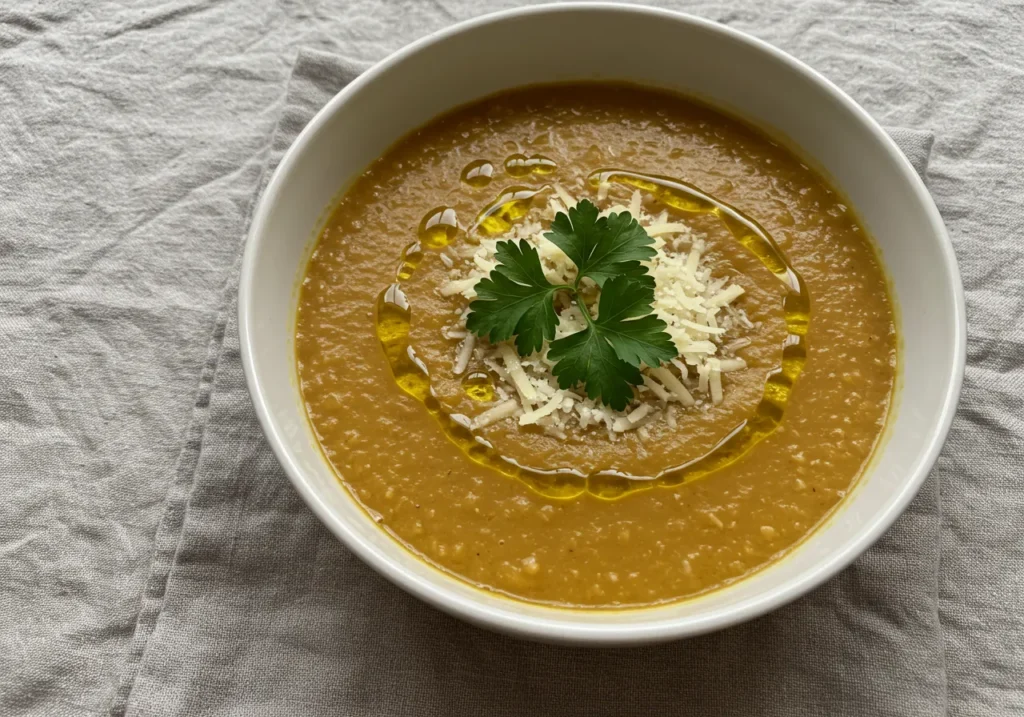Is there anything more comforting than a warm bowl of vegetable soup? It’s hearty, healthy, and feels like a hug in a bowl. But sometimes, no matter how fresh the vegetables are, the soup just feels… flat. If you’ve ever wondered how to add depth of flavor to vegetable soup, you’re in the right place. This guide is your key to transforming a simple soup into a masterpiece of taste.
Table of Contents
Introduction: The Art of Flavorful Vegetable Soup
Let’s face it: making vegetable soup sounds simple. Toss some veggies in a pot, add broth, and let it simmer. Easy, right? Well, yes and no. While anyone can make vegetable soup, turning it into something that sings with layers of flavor requires a little more care and know-how. The secret lies in building flavors step by step, using smart techniques and a few handy tricks.
👉 “Soup is the ultimate slow food—it rewards patience with deliciousness!”
Why Depth of Flavor Matters in Vegetable Soup
What does “depth of flavor” even mean? Think of it as the difference between hearing one note and a whole symphony. A soup with depth is complex, balanced, and keeps you coming back for more. Without it, soup can taste one-dimensional or, worse, bland. Depth makes every spoonful exciting, so let’s dive into how you can achieve it.
Common Mistakes When Making Vegetable Soup
Before we start cooking, let’s address some common pitfalls. These can rob your soup of its full potential:
- Skipping the Sauté: Tossing raw veggies into a pot skips a critical flavor-building step.
- Not Seasoning Properly: Under-salting is one of the biggest culprits of bland soup.
- Overcooking Vegetables: Mushy veggies lose texture and taste.
The good news? These mistakes are easy to avoid with a bit of awareness.
Building a Flavorful Base
Every great soup starts with a strong foundation. Think of this as setting the stage for all the other ingredients to shine.
Choosing the Right Vegetables
Not all veggies are created equal when it comes to soup. Some contribute sweetness, while others bring earthiness or a touch of bitterness. Here’s how to choose wisely:
- Sweet Veggies: Carrots, onions, and sweet potatoes add natural sweetness.
- Earthy Veggies: Mushrooms, parsnips, and celery root give depth.
- Green Veggies: Zucchini and spinach add freshness but shouldn’t dominate.
Mixing a variety ensures a balanced, nuanced flavor.
👉 “Think of your vegetables as the main characters in a play—each one should bring something unique to the table.”
Using Aromatics to Enhance Flavor
Aromatics are your soup’s secret weapon. Onions, garlic, leeks, and shallots are like flavor bombs when cooked correctly. Start by chopping them finely and sautéing them in a little oil or butter. This process caramelizes their natural sugars, unlocking a deep, savory sweetness.
Pro Tip: Add a pinch of salt while sautéing—it helps draw out moisture and boosts flavor early on.
Importance of Proper Vegetable Sautéing
Many people skip this step, but it’s crucial for developing flavor. Sautéing vegetables before adding liquid concentrates their taste, making your soup richer and more delicious. Aim for a golden color on your onions and a slight caramelization on heartier veggies like carrots or celery.
Adding Herbs and Spices for Depth
Herbs and spices are like the supporting cast—they round out the flavor and give your soup personality.
- Fresh Herbs: Thyme, rosemary, and parsley add brightness.
- Dried Herbs: Oregano and bay leaves bring warmth.
- Spices: A pinch of smoked paprika or cumin can add intrigue.
Remember, less is often more. Start with a small amount and adjust as you go.
Layering Flavors Throughout the Cooking Process
Building depth of flavor isn’t just about the ingredients—it’s about when and how you use them.

The Role of Deglazing in Boosting Flavor
After sautéing your vegetables, you might notice a brown layer stuck to the bottom of the pot. Don’t panic—this is called fond, and it’s pure flavor gold. Pour a splash of broth, wine, or water into the pot and scrape it up with a wooden spoon. This step, called deglazing, incorporates all those caramelized bits into your soup.
Balancing Acidity and Sweetness
A little acidity can brighten your soup and make all the flavors pop. Try adding a splash of lemon juice, vinegar, or even a dollop of tomato paste. If the soup feels too sharp, balance it with a touch of honey or sugar. The goal is harmony, not dominance.
Incorporating Umami Ingredients for Complexity
Umami, the so-called fifth taste, adds savory depth to your soup. Here are some powerhouse umami boosters:
- Soy Sauce: A dash adds richness without overpowering.
- Miso Paste: Perfect for an earthy, slightly salty punch.
- Parmesan Rind: Toss it in while simmering for a subtle cheesy note.
Simmering Techniques for Richer Taste
Once your base is ready, it’s time to simmer. Low and slow is the way to go. A gentle simmer allows flavors to meld without overcooking the vegetables. Stir occasionally, and taste as you go to adjust the seasoning.
Enhancing Flavor After Cooking
Sometimes, the finishing touches make all the difference.

Adjusting Seasonings
Once your soup is done, taste it again. Does it need more salt? A pinch of pepper? Don’t be afraid to tweak—it’s all part of the process.
Adding Fresh Herbs Before Serving
A sprinkle of fresh parsley, dill, or cilantro right before serving can add brightness and vibrancy. It’s like adding a pop of color to a painting.
The Power of Finishing Touches: Oils, Nuts, and Cheese
Drizzle a little olive oil or sprinkle some toasted nuts on top for added texture. A few shavings of Parmesan or a dollop of crème fraîche can take your soup to the next level.
Solving Common Problems in Vegetable Soup Recipes
Even with the best intentions, vegetable soup can sometimes miss the mark. Don’t worry—these issues are more common than you think, and they’re all fixable! Let’s tackle some typical soup dilemmas and turn those mishaps into mouthwatering successes.
How to Fix a Bland Soup
Does your soup taste dull, like it’s missing something? You’re not alone—this is a top complaint when it comes to vegetable soup. The good news? There are several ways to bring your soup to life:
- Add Salt Gradually: Often, blandness is just a lack of proper seasoning. Add a pinch of salt, stir, and taste. Repeat until the flavors sing.
- Incorporate Umami: As mentioned earlier, ingredients like soy sauce, miso, or even a dash of Worcestershire sauce can add depth.
- Finish with Acidity: A splash of lemon juice or a drizzle of vinegar can brighten dull flavors instantly.
“Think of seasoning your soup as tuning a guitar—it’s all about finding the perfect harmony.”
Adjusting Consistency Without Diluting Flavor
Maybe your soup is too thick, or perhaps it’s too watery. Here’s how to fix it without compromising flavor:
- Too Thick: Add a splash of broth or water, but make sure to re-season afterward. A thin soup base can handle a bit of extra seasoning.
- Too Thin: Blend some of the cooked vegetables and stir them back into the pot. This thickens the soup naturally and keeps the flavors intact. Alternatively, a tablespoon of cornstarch mixed with water can add body.
Saving Over-Salted Soup
Accidentally overdid the salt? It happens to the best of us. Try these tricks:
- Dilution: Add more liquid (water or unsalted broth) to balance out the salt.
- Starch Solution: Toss in a peeled potato and let it simmer. The potato will absorb some of the salt, acting like a flavor sponge.
- Sweetness: A pinch of sugar or a splash of cream can help counteract saltiness, but be careful not to go overboard.
Innovative Techniques to Make Vegetable Soup Stand Out
Now that you know how to fix common issues, let’s talk about ways to make your soup unforgettable. These tips and tricks will add unique dimensions to your dish, making it worthy of second (and third) helpings.
Using Smoked Ingredients for Unique Depth
Smoked ingredients can add a subtle, intriguing flavor to your soup. Here are some ideas:
- Smoked Paprika: Just a teaspoon can bring a warm, smoky undertone.
- Smoked Salt: Use this in place of regular salt for a gentle smokiness.
- Smoked Vegetables: Roast your vegetables with a sprinkle of smoked seasoning before adding them to the soup.
Incorporating Roasted Vegetables
Roasting vegetables before adding them to your soup caramelizes their natural sugars, creating a deeper, richer flavor. Try roasting carrots, onions, garlic, and even tomatoes until they’re golden and slightly charred. Once roasted, blend them into the soup or leave them chunky for added texture.
The Benefits of Fermented Ingredients
Fermented foods are packed with flavor and a touch of tanginess that can elevate your soup. Try adding:
- Kimchi: Adds a spicy, tangy kick.
- Fermented Garlic Paste: A small spoonful can bring intense savory notes.
- Sauerkraut Brine: A splash of brine brightens the soup without overwhelming it.
Adding Grains and Legumes for Texture and Taste
Grains and legumes are not just great for adding bulk to your soup—they also soak up flavors beautifully.
- Grains: Quinoa, barley, or farro add chewiness and substance.
- Legumes: Lentils, chickpeas, and black beans contribute protein and a creamy texture.
Creative Recipes to Try
Ready to put these techniques into action? Here are a few recipe ideas to inspire your next pot of vegetable soup.
Mediterranean-Inspired Vegetable Soup
Packed with zucchini, tomatoes, olives, and a sprinkle of oregano, this soup bursts with sunny flavors. Add a touch of lemon juice at the end for a fresh finish.
Spicy Thai Vegetable Soup
Coconut milk, red curry paste, and lemongrass come together in this aromatic soup. Toss in sweet potatoes, bell peppers, and a handful of cilantro for an exotic twist.
Creamy Vegan Vegetable Soup
Who says vegan soups can’t be creamy? Blend roasted cauliflower with cashew cream and garlic for a luscious, dairy-free base. Add sautéed mushrooms and fresh parsley to complete the dish.
“Soup isn’t just food—it’s an adventure in a bowl.”
Enhancing Soup with Finishing Touches
Sometimes, it’s the little things that make a big difference. Let’s explore how to add those final flourishes.
Drizzle Some Oil
A swirl of olive oil, chili oil, or even truffle oil adds richness and visual appeal. Think of it as the cherry on top of your soup.
Add Texture with Nuts or Seeds
Toasted nuts, like almonds or walnuts, bring crunch and flavor. Seeds like pumpkin or sunflower are also excellent options.
Top with Cheese
Grate some Parmesan or sprinkle crumbled feta over the soup for a salty, creamy finish. Vegan? Nutritional yeast offers a cheesy flavor without dairy.
Advanced Tips for Achieving Deeper Flavor in Vegetable Soup
Let’s push the envelope with some advanced but simple techniques to make your vegetable soup unforgettable. These methods don’t require fancy tools—just a touch of thoughtfulness and experimentation.
Create a Stock from Scratch
Store-bought broth is convenient, but a homemade stock is the ultimate flavor booster. Here’s how to make one with kitchen scraps:
- Save your vegetable peels, ends, and herbs in a freezer bag.
- Simmer them in water for an hour with salt, pepper, and a bay leaf.
- Strain and use as your soup base.
Homemade stock is like a secret weapon—it’s fresher, richer, and tailored to your taste.
Use Multiple Cooking Methods
Don’t limit yourself to one style of cooking for your vegetables. Try a mix:
- Roast some for sweetness and caramelization.
- Boil others for softness and integration into the broth.
- Sauté aromatics for a deep, savory foundation.
This combination creates layers of texture and flavor that no single method can achieve alone.
Infuse Oil with Aromatics
Flavored oils are a fantastic way to amplify your soup. Heat olive oil gently with garlic, rosemary, or chili flakes, then drizzle it on top of the soup before serving.
Pro Tip: Make a larger batch of infused oil and store it in a jar—it’s a game-changer for all your cooking.
Let the Soup Rest Before Serving
Good things come to those who wait! Allowing your soup to rest for 10–15 minutes off the heat helps the flavors meld together. It’s like letting a cake cool—patience pays off with a better result.
Commonly Asked Questions About Vegetable Soup
We’ve covered a lot of ground, but you might still have a few questions. Let’s clear them up!
Can I Freeze Vegetable Soup?
Absolutely! Vegetable soup freezes beautifully, but there are a few tricks to ensure it stays delicious:
Cool the Soup Completely: Putting hot soup in the freezer can cause condensation, leading to freezer burn.
Use Freezer-Safe Containers: Leave a little space at the top for the soup to expand.
Avoid Freezing Dairy-Based Soups: If your soup has cream, add it after reheating for the best texture.
How Can I Make My Soup Spicier Without Overdoing It?
Start small—add a pinch of chili flakes, a dash of hot sauce, or a slice of fresh chili. Taste as you go. If you overdo it, balance the heat with a touch of cream, coconut milk, or a dollop of yogurt.
What’s the Best Way to Thicken Soup Without Cream?
Blending part of the soup is the easiest method, but here are other options:
Mashed Potatoes: Stir in a small amount for natural thickness.
Cornstarch Slurry: Mix a tablespoon of cornstarch with water and add it to the soup.
Pureed Legumes: Lentils or white beans work wonders for thickening.
Bonus Tips for Making the Best Vegetable Soup
Ready to take your soup to the next level? Here are some extra tips to keep in your back pocket:
Experiment with International Flavors
Your soup doesn’t have to stay traditional! Try adding global twists:
- Indian-Inspired: Add curry powder, turmeric, and coconut milk.
- Italian Flavors: Toss in basil, oregano, and a can of diced tomatoes.
- Mexican Touch: Add cumin, lime juice, and a handful of corn.
Use Fresh Herbs Wisely
Fresh herbs can transform your soup, but timing is key. Add sturdy herbs like rosemary or thyme early in the cooking process, and delicate ones like basil or parsley just before serving. This ensures the herbs don’t lose their vibrant flavor.
Don’t Forget the Bread
Soup and bread are a match made in heaven. A crusty baguette, buttery garlic bread, or even toasted pita chips can make your meal feel complete.
Print
How to Add Depth of Flavor to Vegetable Soup: The Ultimate Guide
- Total Time: 45 minutes
- Yield: 4–6 servings 1x
Description
Vegetable soup is comforting, hearty, and healthy, but it can sometimes lack depth of flavor. This guide walks you through step-by-step techniques to enhance your soup, making it rich, savory, and satisfying. Learn how to layer flavors, balance acidity and sweetness, use umami boosters, and apply professional cooking techniques to create the perfect vegetable soup.
Ingredients
- 2 tbsp olive oil or butter
- 1 large onion, chopped
- 2 carrots, diced
- 2 celery stalks, chopped
- 3 garlic cloves, minced
- 4 cups vegetable broth
- 1 can (14 oz) diced tomatoes
- 1 cup green beans, chopped
- 1 zucchini, diced
- 1 cup potatoes, diced
- 1 cup corn or peas
- 1 bay leaf
- 1 tsp thyme (dried or fresh)
- 1 tsp oregano
- ½ tsp smoked paprika
- ½ tsp cumin (optional, for depth)
- 1 tbsp soy sauce or miso paste (for umami)
- 1 tbsp lemon juice or vinegar (for brightness)
- Salt and pepper to taste
- Fresh parsley or basil for garnish
Instructions
- Sauté the Base – In a large pot, heat olive oil over medium heat. Add onions, carrots, and celery. Sauté for 5–7 minutes until softened.
- Build Flavor – Add garlic, thyme, oregano, smoked paprika, and cumin. Stir for 1 minute to release aromas.
- Deglaze the Pot – Pour in a splash of broth or white wine, scraping up browned bits for extra depth.
- Simmer the Soup – Add the diced tomatoes, remaining vegetable broth, potatoes, and bay leaf. Bring to a boil, then reduce heat to a simmer. Cook for 15 minutes.
- Add Vegetables – Stir in zucchini, green beans, corn, and peas. Simmer for another 10 minutes.
- Enhance Flavor – Remove from heat and stir in soy sauce (or miso paste), lemon juice, salt, and pepper. Adjust seasoning as needed.
- Finish & Serve – Remove bay leaf, garnish with fresh parsley or basil, and enjoy!
Notes
- Roast Some Vegetables First – Roasting carrots, onions, and garlic before adding them deepens the flavor.
- Blend for Creaminess – Blend half the soup for a thicker consistency without cream.
- Add Parmesan Rind – Simmering with a Parmesan rind adds a rich umami depth.
- Balance Flavors – A pinch of sugar or honey balances acidity if the soup tastes too sharp.
- Store & Reheat – Refrigerate for up to 5 days or freeze for longer storage. Reheat with a splash of broth if too thick.
- Prep Time: 15 minutes
- Cook Time: 30 minutes
- Category: Soup
- Method: Stovetop
- Cuisine: International
Final Thoughts: The Art of Crafting Perfect Vegetable Soup
This brings us to the end of our soup-making journey. By following the steps and techniques we’ve discussed, you can create a vegetable soup that’s not just delicious but bursting with layers of flavor. Remember, it’s all about patience, experimentation, and using the right techniques to bring out the best in your ingredients.
For even more tips, check out these fantastic resources:
- Curious about how to adjust your ingredients for different tastes? This guide on what meat goes well with mashed potatoes offers great pairing advice that could inspire your next soup meal.
- If you want to take your broth game up a notch, explore this article on substituting beef broth for bouillon cubes for insights on building a rich, hearty base.
- Considering unique toppings or add-ins? Discover creative ideas in this piece on the best potatoes for soup, which might be just what your vegetable soup needs.
With these tips and resources, your next bowl of soup will be nothing short of extraordinary. So, roll up your sleeves, grab your favorite vegetables, and start cooking. The possibilities are endless, and the results are oh-so-rewarding! 🍲

